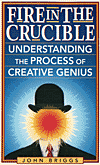
Fire In The Crucible: Understanding the Process of Creative Genius
John Briggs
$17.95
Paperback
382 pages
©2000
ISBN
1-890482-77-3
Phanes Press
616-868-1097
|
|
|
 |
 |
|
Author John Briggs explores the roots of the creative spirit by studying the minds and lives of creative individuals.
“An exuberant voyage through the brains and minds of creative individuals, chock-full of intriguing scientific discoveries and puzzling paradoxes... John Briggs’s enthusiasm is infectious.”  Howard Gardner, Harvard University Professor of Education; author, Multiple Intelligences Howard Gardner, Harvard University Professor of Education; author, Multiple Intelligences
Albert Einstein, Ludwig von Beethoven, Leonardo da Vinci, Virginia Woolf, and Thomas Edison... are these minds like our own? Or are they in some respects so vastly different they should qualify as another species? Everyone agrees: they shared the spark of genius.
Do we all have the potential for genius? Possibly  but what do you think is the key to creative thought and achievements? A burning desire to be innovative? A touch of madness? A high IQ coupled with the passion of a loner? None of the above, says John Briggs, author of Fire in the Crucible: Understanding the Process of Creative Genius. but what do you think is the key to creative thought and achievements? A burning desire to be innovative? A touch of madness? A high IQ coupled with the passion of a loner? None of the above, says John Briggs, author of Fire in the Crucible: Understanding the Process of Creative Genius.
In the final analysis, Briggs concludes that geniuses aren’t necessarily smarter or more talented than other people. But they are more driven to focus on the nuances and contradictory feelings most other people choose to suppress. They don’t feel obliged to strictly define all that they see and feel, but rather savor ambiguity, live with fuzzy edges, and work to invent a language to express their perception of nuance. It is, in part, subtle and contradictory feelings and perceptions that are the true source of creativity, Briggs argues.
“Nuance” is therefore a central element of genius. It refers to the subtle feeling tones, the aura or energy that surrounds or infuses a thought or conviction. Psychiatrist Erich Fromm called a sensitivity to nuance “full awareness,” and many artists and scientists can describe the unique sensation when the nuance or feeling tone associated with a problem finally “clicks” at the moment of solution.
In this comprehensive yet easily readable work, Briggs has created a dynamic narrative woven out of lively biographical material and probing interviews with past and recent geniuses in the arts and sciences. The subjects viewed range from Jorge Luis Borges, Charles Darwin, and Ernest Hemingway to Georgia O’Keeffe, Niels Bohr and Nikola Tesla.
The book is in three parts. The first section defines creative vision and attempts to explain from where it springs. The second examines the different elements of genius, including “talent,” “madness,” and the ability to think using contradictions. The last section describes the creator’s process of nurturing the germ of a work as it unfolds into wholeness.
In preparing this volume, Briggs combed hundreds of books and articles, interviewed neurophysiologists, historians of science, psychologists, psychiatrists, systems theorists, and other creativity researchers, combining their latest findings with his own training in aesthetics, his background as a science writer and reporter.
Fire in the Crucible is an inspiration to all who are involved in the creative process. It clearly demonstrates that each person’s individual nature is the central element of the creative process. Briggs’s work gives absolute primacy to the reader’s own sense of nuance as the source of genius. As the author himself says, this book “is essentially about the roots of creativity.., about what is best, what is deepest in life.” As we follow him through this fascinating maze, we discover the curious fact that geniuses are not born, nor are they made. The truth lies somewhere in-between. “We may all have in us intuitions and perceptions that could take us to the deepest place that genius inhabits...”
ABOUT THE AUTHOR:
John Briggs is a professor of English of Western Connecticut State University, has taught at the New School for Social Research in New York, and holds a doctorate in aesthetics and psychology He is the author of Fractals: The Patterns of Chaos, and co-author, with physicist F. David Peat, of Turbulent Mirror: An Illustrated Guide to Chaos Theory and the Science of Wholeness, and Seven Life Lessons of Chaos: Timeless Wisdom from the Science of Change.
|